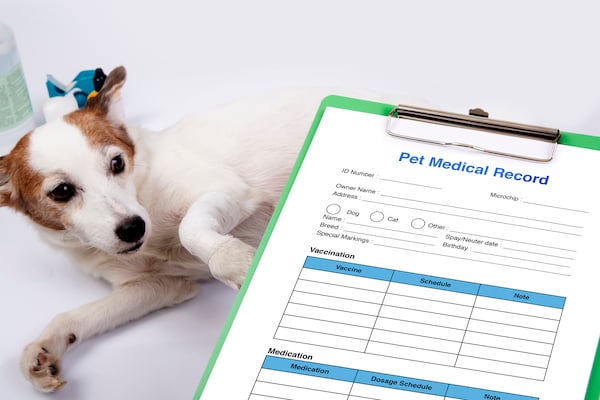- This post contains affiliate links. Read more here.
- Not a substitute for professional veterinary help.
Pet insurance is, for the most part, a lot like human health insurance—it’s there to protect you financially in the event of accidents or illnesses that see your best four-legged friend racking up the vet bills. But it differs from your own health plan in one especially critical way: pre-existing conditions.
Virtually no pet insurance company will cover the treatment of any medical condition your pet had before a policy went into effect. It’s one of the trickiest hurdles pet parents have to navigate when shopping for a plan: Is pet insurance still worth it if your dog or cat wouldn’t be covered for the medical conditions they’ve already been diagnosed with?
Read on for our answers to common questions about pre-existing conditions and what you can do to find a policy that works for you.
What Are Pre-Existing Conditions?
Pre-existing conditions are health issues that have been detected (either through a formal diagnosis or a record of symptoms) before you purchased your pet insurance policy.
For example, let’s say that at your Miniature Dachshund’s annual checkup last year, your vet spotted some early warning signs of Intervertebral Disc Disease and recommended a joint supplement. Shortly after that, you purchased pet insurance. Now a year has passed, and your pup is having trouble getting up and down the stairs—your vet officially diagnoses IVDD and recommends back surgery to relieve the pressure on your dog’s spine. Will your pet insurance policy cover it?

NORRIE3699 via iStock
Unfortunately, it probably won’t. Your pet’s medical record will show that the symptoms of disc disease predate your policy, which makes it likely that your insurance company will consider disc disease—and most spinal ailments—a pre-existing condition.
If, however, your dog gets into medical trouble that’s unrelated to his spine and any other pre-existing conditions (develops a chronic ear infection, for example, or gastric reflux), your pet insurance company should be on the hook.
Last, let’s imagine that you did get pet insurance before you or your vet noticed any signs of disc disease. Your vet recommends surgery, and your insurance policy covers it. Your pup recovers, but after another couple years, your vet recommends another spinal procedure. Will your pet insurance policy cover that?
They certainly should. A pre-existing condition isn’t “any condition that your pet has had before”—it’s just a condition that predates your insurance policy.
How Does Your Insurance Company Know What Counts as a Pre-Existing Condition?
The short answer is they look at your pet’s medical records. Some companies request that your pet has a full medical exam prior to enrollment, or they’ll ask for a copy of your pet’s medical records when you sign on. Others, like ManyPets, will request some portion of your pet’s medical records at the time of your first claim.

andpstock001 via iStock
A few companies, notably Embrace, will allow you to request a “medical history review” when you enroll—which means your insurance company will look at your pet’s medical records and tell you up front what they’ll consider a pre-existing condition. That can help you avoid surprises down the road and decide right away if you’d rather opt out or modify your plan.
Remember that when you switch insurance companies, your pre-existing conditions will likely reset; your new insurance company will consider anything that happened on your old insurance company’s watch a pre-existing condition.
How Is a Pre-Existing Condition Different from a Congenital or Hereditary Condition?
A hereditary condition is a medical disorder that’s inherited genetically, while a congenital condition is one that develops in utero and is present from birth. Both sound like they would be pre-existing conditions by definition—but a good pet insurance plan won’t necessarily regard either hereditary or congenital conditions as pre-existing.
Hereditary conditions typically go hand-in-hand with certain breeds. Hip dysplasia, for example, is one of the most common hereditary conditions and is especially prevalent in large breeds like Great Danes, German Shepherds, and Labrador Retrievers. Though the genetic predisposition to it is there, most dogs don’t show signs of it immediately. So if your insurance policy goes into effect before symptoms present, a good plan should cover treatment.

Fly_dragonfly via iStock
Note that some companies have longer wait periods than others when it comes to hereditary conditions. For example, Healthy Paws will cover treatment for hip dysplasia—but only 1) if your pet is under the age of six at the time of enrollment and 2) after a wait period of one year after your insurance policy starts.
As you’re choosing pet insurance, it’s important to know what kinds of hereditary conditions your pet might be predisposed to so you can choose a plan that offers you the shortest wait times.
As for congenital conditions, whether you can expect coverage typically depends on whether symptoms present immediately or not. Congenital heart disease, for example, may not be immediately obvious, and if you purchase a policy before symptoms appear, a good provider should cover treatment.
Because policies on hereditary and congenital conditions vary from company to company, it’s always a good idea to check out a prospective policy’s fine print on both and do some comparison shopping.
What Are “Treatable” or “Curable” Pre-Existing Conditions?
Though no pet insurance company will cover a pre-existing condition, a few will cover what they call a “treatable” or “curable” pre-existing condition.
Definitions and wait periods vary from company to company, but an exemption for a “curable” pre-existing condition might look something like this: Imagine that last year, your cat had a urinary tract infection, and you went to the vet for antibiotics. The pills cleared it right up, and your cat was right as rain for the next twelve months. You then purchase pet insurance, and the following month, your cat gets another UTI. Will your pet insurance company cover treatment?

Yelena Shander via iStock
The ones that cover “curable” pre-existing conditions should—provided enough time has elapsed since your pet’s last treatment. Embrace, for example, would likely cover your cat’s UTI as long as 12 consecutive months had passed since the last appearance of symptoms.
There is, however, a lot of gray area here, and some companies, like Figo, are especially vague about how they’ll define “curable.” If your cat had just the one UTI prior to your policy’s start date, that’s likely covered. But if your cat had a history of chronic UTIs before you enrolled, your chances of finding the next UTI covered are slimmer.
What’s a Bilateral Condition?
A bilateral condition is a medical condition that can occur on either side of the body—like knee and hip injuries. Because an injury on one side increases the likelihood of injury on the other, most pet insurance companies will treat bilateral conditions as pre-existing conditions.
Here’s an example: Imagine that several years ago, your dog’s cruciate ligament on the left side ruptured. You brought them in for surgery, and now they’re good as gold. You buy pet insurance, and two years later, your dog ruptures their cruciate ligament on the right side. It’s a different leg that showed no signs of problems prior to your policy’s start date, and you’ve long since passed all your insurance company’s wait periods, so you should be covered, right?
Unfortunately, it’s unlikely. Most insurance companies will consider the same injury on the other side of your pet’s body a bilateral condition—meaning it counts as a pre-existing condition.
But if you took out your insurance policy before symptoms of a cruciate rupture appeared on either side, a good insurance policy should cover both surgeries.
Do Pre-Existing Conditions Affect My Premiums?
No—you can’t be denied coverage or have your premiums raised as a result of pre-existing conditions. Nor can your rate go up based on the number of claims you make.
What will raise your premiums, however, is your pet’s age. Older pets are more expensive to insure, and only a few companies (notably Trupanion and Healthy Paws) don’t raise prices as a pet ages. If you see your rates going up over the years, that’s probably time and rising veterinary costs at work—not pre-existing conditions.

Capuski via iStock
Should I Still Get Pet Insurance Even If My Pet Has a Pre-Existing Condition?
Maybe! The simple answer is that it depends on your situation.
The example a lot of insurance companies offer is cancer. Even if your pet has had two knee surgeries, gastric reflux, and a dozen ear infections, it’s likely that a policy you buy today would still cover you for cancer treatment. According to the American Veterinary Medical Association, almost half of dogs over the age of ten will develop cancer. Successful treatment is more possible now than ever before—but the cost can easily exceed $10,000.
If your dog gets cancer, pet insurance will undoubtedly have been a good deal, especially if you’re not sure you could afford treatment otherwise.
But what if they don’t? It’s true that you’re unlikely to find most of a very old pet’s ailments covered, in which case you might decide you’d rather rely on your savings account or an emergency plan like Pawp. But if your pet only has one or two pre-existing conditions, there’s a whole world of accidents and illnesses out there that would likely be covered.
Ultimately, you’re the expert on your pet and your finances and best equipped to know what’s right for you. Get some quotes, do some math, and weigh some budgets—we’re rooting for you!
What’s the Best Pet Insurance for Pre-Existing Conditions?
We partnered with Pet Insurer to compare nine top pet insurance companies across a wide range of criteria—including pre-existing conditions. Read on to see the breakdown.
